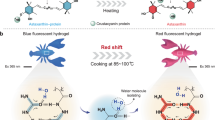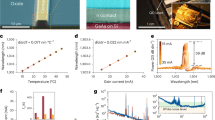Abstract
Lasing typically starts from fluorescence, and the laser wavelength is therefore limited to the fluorescence spectrum of the gain material. Accessing wavelengths beyond this intrinsic emission spectrum requires emission assisted by multiphonon processes. However, this is much weaker than the fluorescence originating from direct transitions between electronic energy levels, which only involve a small number of phonons. Here, we present the realization of lasers far beyond the fluorescence spectrum in Yb-doped YCa4O(BO3)3 crystals. We selectively amplify three- to eight-phonon processes and suppress all the fewer-phonon ones, which we attribute to constructive interactions of vibrational modes from free oxygen sites. We obtain an overall spectral tuneability of 1,110–1,465 nm in five segments, each with its own configuration, corresponding to the three- to seven-phonon cases. The longest (eight-phonon) lasing wavelength can reach 1,518 nm, over 400 nm beyond the fluorescence spectrum. Our results shed light on strengthening the original weak electron–phonon–photon interaction and give rise to a search for on-demand lasers operating outside the fluorescence spectrum.
This is a preview of subscription content, access via your institution
Access options
Access Nature and 54 other Nature Portfolio journals
Get Nature+, our best-value online-access subscription
$29.99 / 30 days
cancel any time
Subscribe to this journal
Receive 12 print issues and online access
$209.00 per year
only $17.42 per issue
Buy this article
- Purchase on Springer Link
- Instant access to full article PDF
Prices may be subject to local taxes which are calculated during checkout




Similar content being viewed by others
Data availability
Source data are available for this paper. All other data that support the findings of this study are available from the corresponding author upon reasonable request. Source data are provided with this paper.
References
Maiman, T. H. Stimulated optical radiation in ruby. Nature 187, 493–494 (1960).
Sugioka, K. & Cheng, Y. Ultrafast lasers—reliable tools for advanced materials processing. Light. Sci. Appl. 3, e149 (2014).
Kaushal, H. & Kaddoum, G. Optical communication in space: challenges and mitigation techniques. IEEE Commun. Surv. Tutor. 19, 57–96 (2016).
Ofelt, G. S. Intensities of crystal spectra of rare-earth ions. J. Chem. Phys. 37, 511–521 (1962).
Judd, B. R. Optical Absorption intensities of rare-earth ions. Phys. Rev. 127, 750–761 (1962).
Hehlen, M. P., Mikhail, G. B. & Karl, W. K. 50th anniversary of the Judd–Ofelt theory: an experimentalist’s view of the formalism and its application. J. Lumin. 136, 221–239 (2013).
Zhu, S., Zhu, Y. & Ming, N. Quasi-phase-matched third-harmonic generation in a quasi-periodic optical superlattice. Science 278, 843–846 (1997).
Ferreira, M. S. & Wetter, N. U. Diode-side-pumped, intracavity Nd:YLF/KGW/LBO Raman laser at 573 nm for retinal photocoagulation. Opt. Lett. 46, 508–511 (2021).
Khurgin, J. B., Clerici, M. & Kinsey, N. Fast and slow nonlinearities in epsilon‐near‐zero materials. Laser Photonics Rev. 14, 2000291 (2020).
Johnson, L. F., Dietz, R. E. & Guggenheim, H. J. Optical maser oscillation from Ni2+ in MgF2 involving simultaneous emission of phonons. Phys. Rev. Lett. 11, 318–320 (1963).
Pohl, R. W. Electron conductivity and photochemical processes in alkali-halide crystals. Proc. Phys. Soc. 49, 3–31 (1937).
Hellwege, K. H. On the fluorescence and the coupling between electron terms and crystal lattices in aqueous salts of rare earths. Ann. Phys. 40, 529–542 (1941).
Alkauskas, A. et al. First-principles theory of the luminescence lineshape for the triplet transition in diamond NV centres. N. J. Phys. 16, 073026 (2014).
Moulton, P. F. Tunable solid-state lasers. Proc. IEEE 80, 348–364 (1992).
Sennaroglu, A. Broadly tunable Cr4+-doped solid-state lasers in the near infrared and visible. Prog. Quantum Electron. 26, 287–352 (2002).
Basiev, T. T., Mirov, S. B. & Osiko, V. V. Room-temperature color center lasers. IEEE J. Quantum Elect. 24, 1052–1069 (1988).
Moulton, P. F. Spectroscopic and laser characteristics of Ti:Al2O3. J. Opt. Soc. Am. B 3, 125–133 (1986).
Walling, J. C. et al. Tunable alexandrite lasers. IEEE J. Quantum Elect. 16, 1302–1315 (1980).
Moulton, P. F. An investigation of the Co:MgF2 laser system. IEEE J. Quantum Elect. 21, 1582–1595 (1985).
Peters, R. et al. Broadly tunable high-power Yb:Lu2O3 thin disk laser with 80% slope efficiency. Opt. Express 15, 7075–7082 (2007).
Gao, Z. et al. Diode-pumped self-starting mode-locked femtosecond Yb:YCa4O(BO3)3 laser. Chin. Phys. B 23, 054207 (2014).
Loiko, Pavel et al. Highly efficient 2.3 µm Thulium lasers based on a high-phonon-energy crystal: evidence of vibronic-assisted emissions. J. Opt. Soc. Am. B 38, 482–495 (2021).
Di Bartolo, B. Optical Interactions in Solids (World Scientific, 2010).
Huang, K. & Rhys, A. Theory of light absorption and non-radiative transitions in F-centres. Proc. R. Soc. Lond. A 204, 406–423 (1950).
Ellens, A. et al. Spectral-line-broadening study of the trivalent lanthanide-ion series. II. The variation of the electron–phonon coupling strength through the series. Phys. Rev. B 55, 180–186 (1997).
Demirbas, U. & Baali, I. Power and efficiency scaling of diode pumped Cr:LiSAF lasers: 770–1110 nm tuning range and frequency doubling to 387–463 nm. Opt. Lett. 40, 4615–4618 (2015).
Chen, P. et al. 12.3-W output power and 271-nm wavelength tunability of diode-double end-pumped Tm:CALYO laser. Opt. Laser Technol. 152, 108095 (2022).
Pinto, J. F. et al. Improved Ti: sapphire laser performance with new high figure of merit crystals. IEEE J. Quantum Elect. 30, 2612–2616 (1994).
Caro, P. Phonon interference in the analysis of rare earth 4fn energy level sequences. J. Less-Common Met. 126, 239–245 (1986).
Kaminskii, A. A. et al. High-order stimulated Raman scattering combined with second harmonic generation in [χ(2)+χ(3)]-nonlinear LaBGeO5, β′-Gd2(MoO4)3 and Ca4Gd(BO3)3O laser host crystals under picosecond excitation. J. Raman Spectrosc. 29, 645–648 (1998).
Maczka, M. et al. Lattice dynamics of Ca4GdO(BO3)3. J. Raman Spectrosc. 35, 266–273 (2004).
Lupei, A. et al. Selective excitation study of Yb3+ in GdCa4O(BO3)3 and YCa4O(BO3)3. J. Phys. Condens. Matter 14, 1107–1117 (2002).
Dirksen, G. J. & Blasse, G. Tetracalcium gadolinium oxoborate Ca4GdO(BO3)3 as a new host lattice for luminescent materials. J. Alloy. Compd. 191, 121–126 (1993).
Blasse, G. Rare earth spectroscopy in relation to materials science. Mater. Chem. Phys. 31, 3–6 (1992).
Loiko, P. et al. Watt-level europium laser at 703 nm. Opt. Lett. 46, 2702–2705 (2021).
Koechner, W. & Bass, M. Solid-State Lasers (Springer-Verlag, 2003).
Samuel, I. D. W. et al. How to recognize lasing. Nat. Photonics 3, 546–549 (2009).
Fibrich, M. et al. Influence of temperature on Ti: sapphire spectroscopic and laser characteristics. Laser Phys. 28, 085801 (2018).
Kerridge, W. R. & Damzen, M. J. Temperature effects on tunable cw alexandrite lasers under diode end-pumping. Opt. Express 26, 7771–7785 (2018).
Blasse, G. Interaction between optical centers and their surroundings: an inorganic chemist’s approach. Adv. Inorg. Chem. 35, 319–402 (1990).
Acknowledgements
This work was supported by the National Key Research and Development Program of China (grant nos. 2021YFB3601504 and 2021YFA0717800) and the Natural Science Foundation of China (grant nos. 52025021, 92163207, 51890863 and 52002220). F.L. acknowledges the support of Future Plans of Young Scholars at Shandong University. F.L. acknowledges H. Si and Y. Cheng for support with laser measurements. F.L. acknowledges W. Liu, J. Feng, and G. Zhang for crystal growth of Yb:La2CaB10O19, Gd:Na3La9O3(BO3)8, Li3K9Gd3(BO3)7 and Rb7SrGd2(B5O12)3.
Author information
Authors and Affiliations
Contributions
H.Y. and H.Z. conceived and supervised the project. F.L., C.H. and D.L. performed the laser experiments and wrote the manuscript. Q.F. performed some laser experiments. Y.F. performed some spectral measurements. Y.-F.C. provided helpful suggestions and theoretical analysis on the electron–phonon coupling effect. All authors contributed to the discussion and the preparation of the manuscript.
Corresponding authors
Ethics declarations
Competing interests
The authors declare no competing interests.
Peer review
Peer review information
Nature Physics thanks Anton Husakou and the other, anonymous, reviewer(s) for their contribution to the peer review of this work.
Additional information
Publisher’s note Springer Nature remains neutral with regard to jurisdictional claims in published maps and institutional affiliations.
Supplementary information
Supplementary Information
Supplementary Figs. 1–27, discussion and Tables 1–5.
Source data
Source Data Fig. 3
Laser wavelength and laser power.
Source Data Fig. 4
Raman spectrum and phonon dispersion.
Rights and permissions
Springer Nature or its licensor holds exclusive rights to this article under a publishing agreement with the author(s) or other rightsholder(s); author self-archiving of the accepted manuscript version of this article is solely governed by the terms of such publishing agreement and applicable law.
About this article
Cite this article
Liang, F., He, C., Lu, D. et al. Multiphonon-assisted lasing beyond the fluorescence spectrum. Nat. Phys. 18, 1312–1316 (2022). https://doi.org/10.1038/s41567-022-01748-z
Received:
Accepted:
Published:
Issue Date:
DOI: https://doi.org/10.1038/s41567-022-01748-z
This article is cited by
-
Phonon engineering in Yb:La2CaB10O19 crystal for extended lasing beyond the fluorescence spectrum
Light: Science & Applications (2023)
-
Photon-phonon collaboratively pumped laser
Nature Communications (2023)
-
Light in the darkness
Nature Physics (2022)



